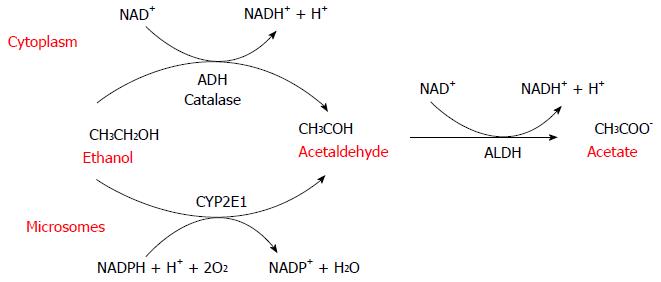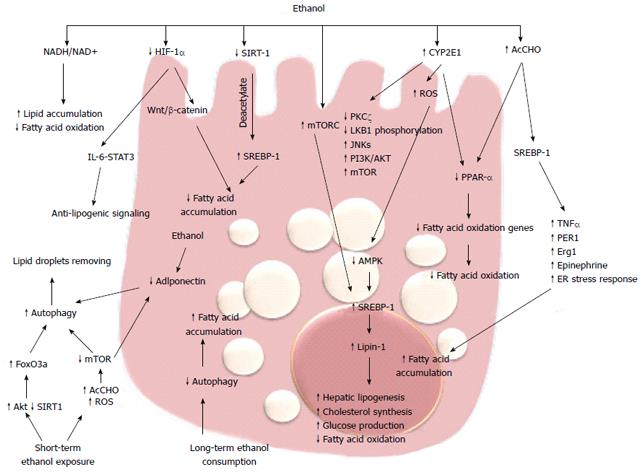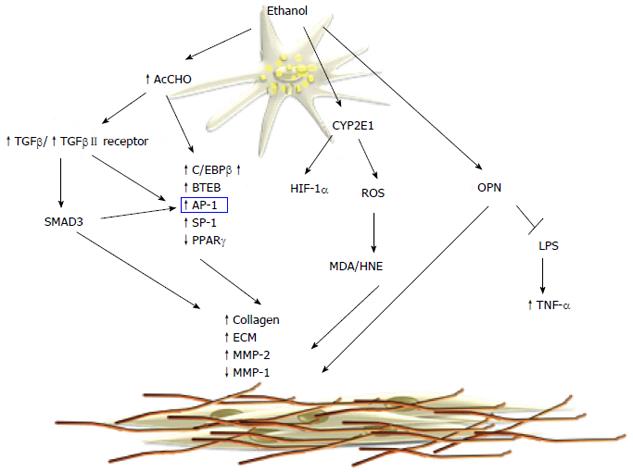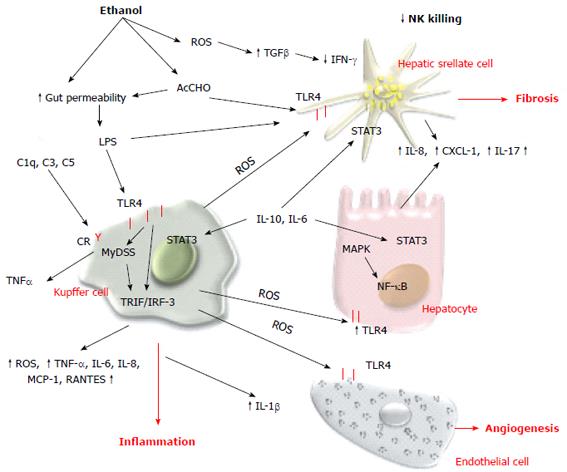Copyright
©2014 Baishideng Publishing Group Inc.
World J Gastroenterol. Dec 21, 2014; 20(47): 17756-17772
Published online Dec 21, 2014. doi: 10.3748/wjg.v20.i47.17756
Published online Dec 21, 2014. doi: 10.3748/wjg.v20.i47.17756
Figure 1 Alcohol metabolism.
Alcohol dehydrogenase (ADH) is the main cytosolic enzyme that converts alcohol to acetaldehyde. The inducible microsomal enzyme also forms acetaldehyde. The toxic metabolite acetaldehyde is then further oxidized to acetate by the mitochondrial aldehyde dehydrogenase (ALDH).
Figure 2 Molecular mechanisms of alcoholic fatty liver.
Alcohol consumption via multiple pathways increases the expression of SREB-1 and downregulates PPAR-α, promoting fatty acid synthesis and impairing β-oxidation, thus resulting in fatty acid accumulation. Long-term ethanol consumption promotes fatty acid accumulation through decreased autophagy, while short-term ethanol exposure promotes autophagy and degradation of lipid droplets. HIF: Hypoxia inducible factor; ROS: Reactive oxygen species.
Figure 3 Molecular mechanisms of alcoholic fibrosis.
Acetaldehyde causes increased synthesis of collagen and extracellular matrix (ECM) components through the activation of the transforming growth factor (TGF)-β/SMAD3 signaling pathway. The microsomal metabolism of ethanol leads to protein adduct formation that upregulates collagen synthesis. MDA: Malondialdehyde; OPN: Osteopontin; LPS: Lipopolysaccharide; TNF-α: Tumor necrosis factor-α; MMP: Metalloproteinase; HNE: Hydroxynonenal; AP-1: Activator protein-1; SP-1: Specificity protein-1.
Figure 4 Alcohol and innate immune response.
Both alcohol and acetaldehyde increase the intestinal permeability and lipopolysaccharide (LPS) level in the portal circulation. LPS binds to TLR4 and induces the proinflammatory phenotype of Kupffer cells. Acetaldehyde and LPS also stimulate parenchymal and nonparenchymal cells to produce proinflammatory cytokines and chemokines. The innate immune system also releases anti-inflammatory and hepatoprotective cytokines that activate STAT3 signaling in liver cells. ROS: Reactive oxygen species; LPS: Lipopolysaccharide; TLR4: Toll-like receptor 4; TNF-α: Tumor necrosis factor-α; IFN-γ: Interferon-γ; IL: Interleukin; NF-κB: Nuclear factor-κB.
- Citation: Ceni E, Mello T, Galli A. Pathogenesis of alcoholic liver disease: Role of oxidative metabolism. World J Gastroenterol 2014; 20(47): 17756-17772
- URL: https://www.wjgnet.com/1007-9327/full/v20/i47/17756.htm
- DOI: https://dx.doi.org/10.3748/wjg.v20.i47.17756












